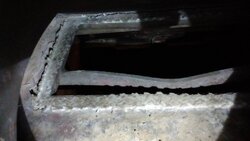Still not cold enough yet for fires, but I wanted to test it out for exactly this reason. First off, It's an all new old stove to me. Princess insert. Brand new liner I installed. First problem....Smoking from what I think is caulk/silicone mix I used to seal up the block off plate, and around the liner. Just started smoking bad and stinking. Definitely wasn't wood smoke. I used this because I seen people posting here that they used that without a problem. I was leary, and went ahead and tried it anyways. So, I guess I'll rip her all out, and redo it, at least around the liner itself where it gets the hottest with high temp stuff.
Second problem. Cat didn't act like it was working correctly. I never seen it glow. I was using cut up 2x4, so I know it was dry enough. Again, cat gauge was half way up to max, way pass the engage area. There was also all kinds of smoke coming out of the chimney smoking up my new liner. Didn't change a whole lot from engaged to not engaged. I may have to order a new one. Not sure if I need a new gasket as well that fits the door that comes down? Not the one around the cat, but there's another gasket up there for the by pass.
Third problem. There's something wrong with the flap that's attached to the chain that's attached to the t'stat. When in the full closed position, there's plenty of slack in the chain to allow this flap to close all the way. The problem is that it doesn't close all the way straight without me nudging it back to square, and push down on it to get it to close all the way. It's like I need to glue a finger or guide for it to close straight instead of cock eyed, leaving a hole open in the corner, and then somehow get it to close all the way on it's own. Again, there's plenty of slack in the chain, it just doesn't want to guide itself down all the way, and straight.
All in all, not an impressive first start, but at least I know what's up now while I still have a few weeks to a month before it's really time to keep a fire going full time.
Second problem. Cat didn't act like it was working correctly. I never seen it glow. I was using cut up 2x4, so I know it was dry enough. Again, cat gauge was half way up to max, way pass the engage area. There was also all kinds of smoke coming out of the chimney smoking up my new liner. Didn't change a whole lot from engaged to not engaged. I may have to order a new one. Not sure if I need a new gasket as well that fits the door that comes down? Not the one around the cat, but there's another gasket up there for the by pass.
Third problem. There's something wrong with the flap that's attached to the chain that's attached to the t'stat. When in the full closed position, there's plenty of slack in the chain to allow this flap to close all the way. The problem is that it doesn't close all the way straight without me nudging it back to square, and push down on it to get it to close all the way. It's like I need to glue a finger or guide for it to close straight instead of cock eyed, leaving a hole open in the corner, and then somehow get it to close all the way on it's own. Again, there's plenty of slack in the chain, it just doesn't want to guide itself down all the way, and straight.
All in all, not an impressive first start, but at least I know what's up now while I still have a few weeks to a month before it's really time to keep a fire going full time.


 and feel for any buildup around the bypass gasket that could be causing problems, for future reference.
and feel for any buildup around the bypass gasket that could be causing problems, for future reference.